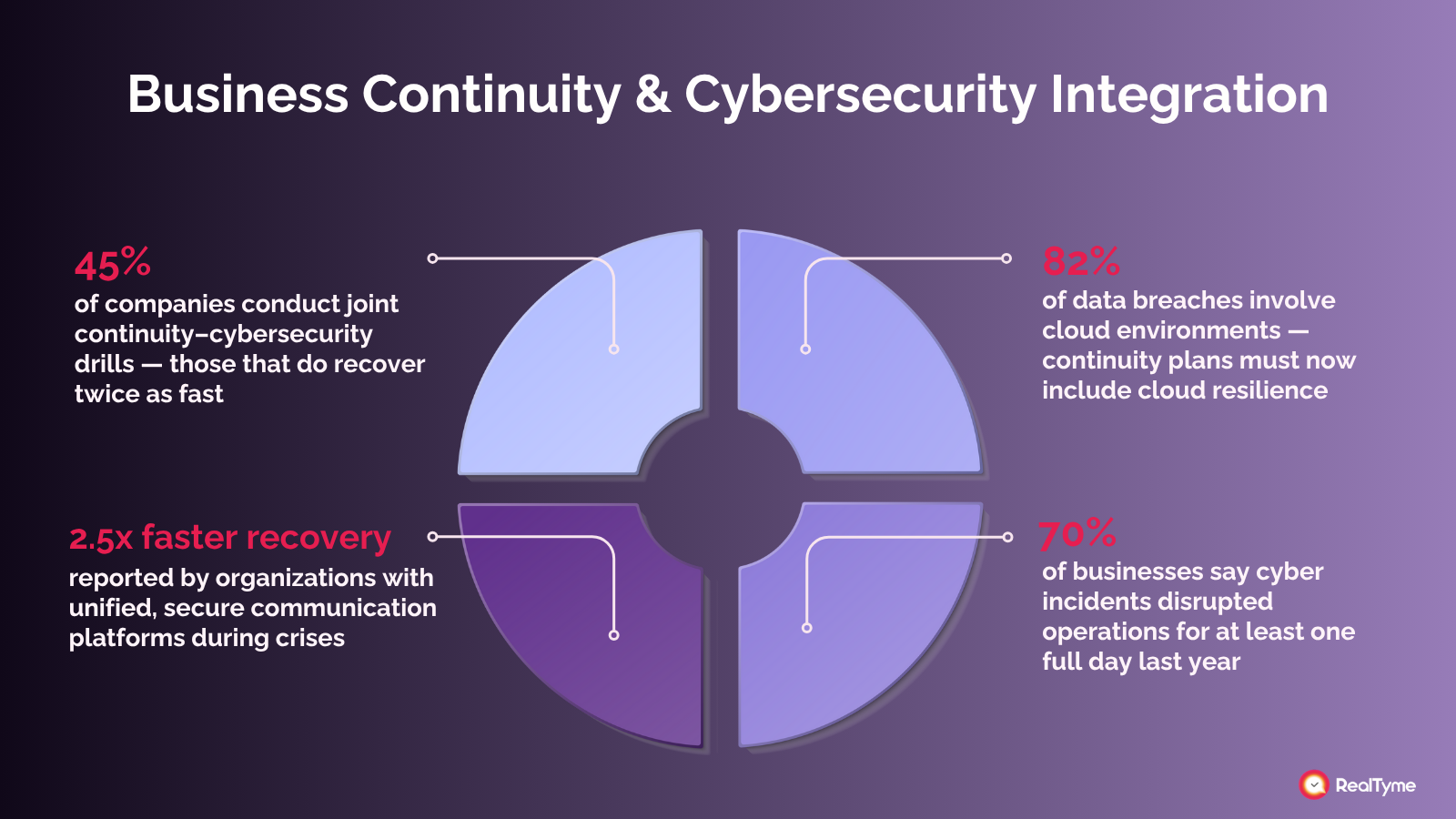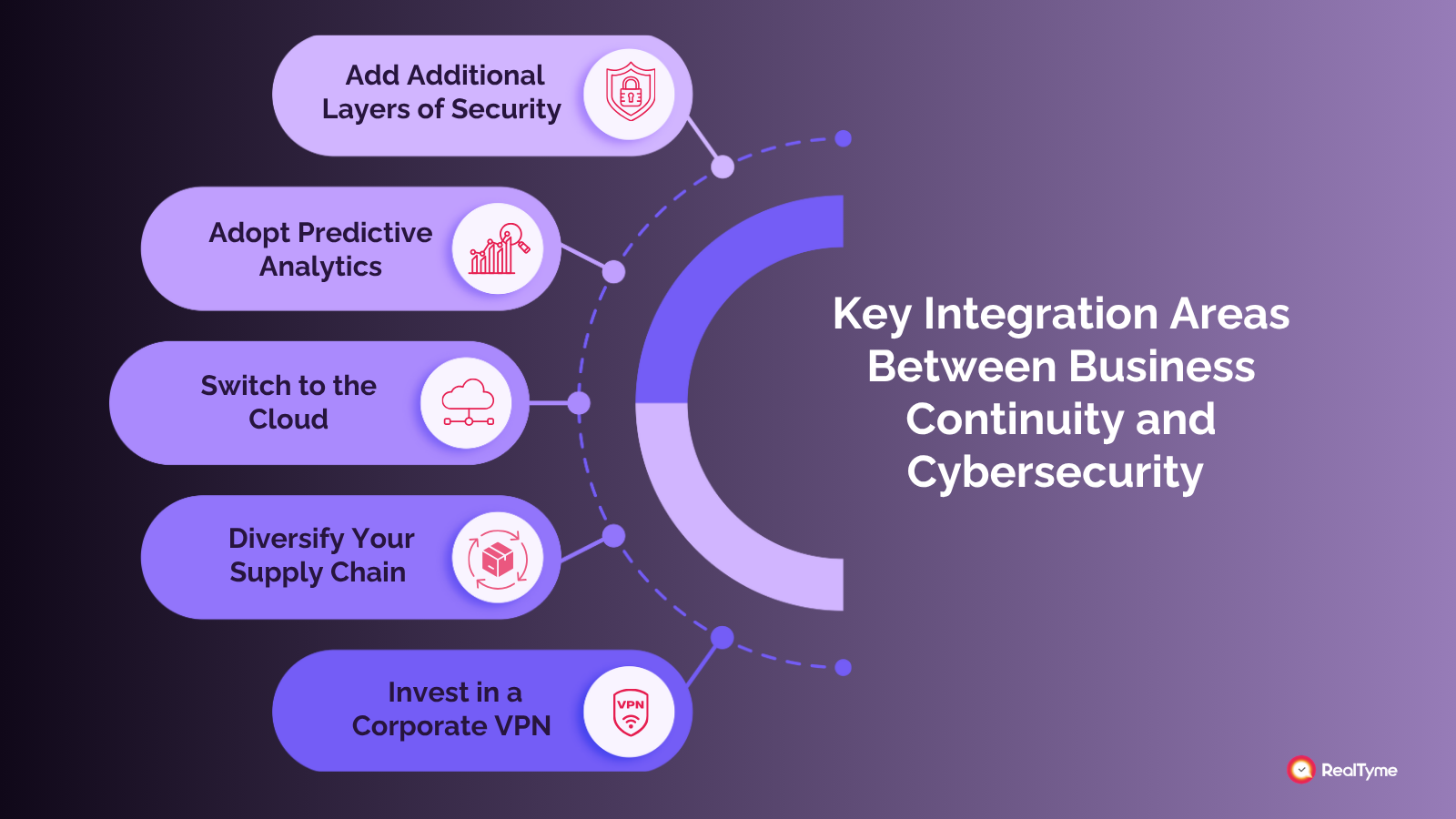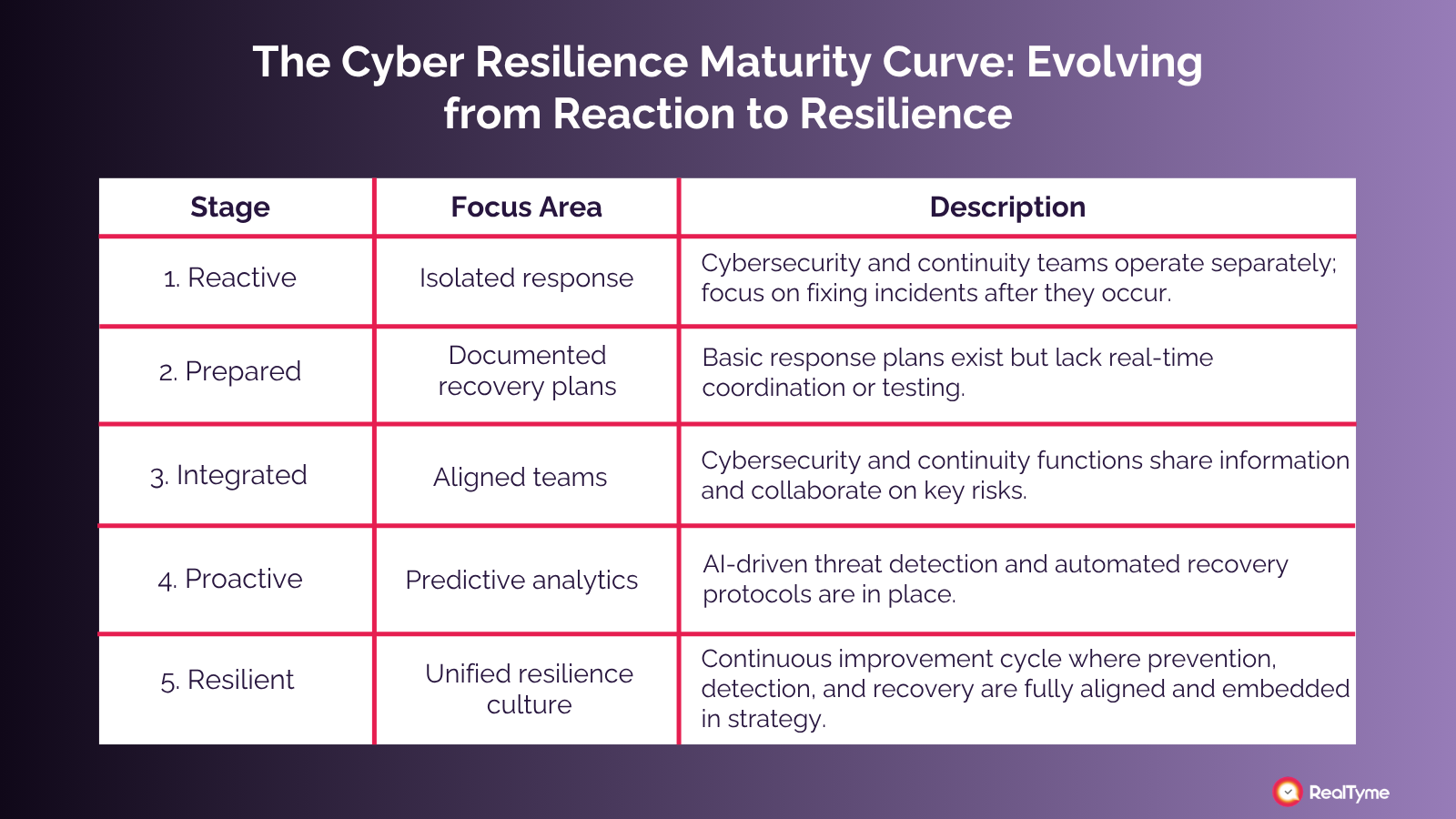The Hidden Link Between Business Continuity and Cybersecurity

No business is immune to disruption. A single cyberattack, system outage, or data breach can bring operations to a standstill, compromise sensitive information, and damage hard-earned trust in an instant.
Yet, many organizations still treat cybersecurity and business continuity as two separate priorities. In reality, they’re deeply connected. When combined, they form the backbone of true organizational resilience helping businesses not just defend against threats, but also recover quickly and keep running smoothly when the unexpected happens.
The Crucial Connection Between Cybersecurity and Business Continuity
When a crisis strikes, whether it’s a ransomware attack, a power outage, or a cloud service failure, the real question isn’t if it will happen, but how prepared your organization is to respond.
That’s where business continuity and cybersecurity come together.
Business continuity focuses on keeping the lights on, ensuring that critical operations continue even when things go wrong. It’s what allows an airline to keep flights on schedule during a network outage or a hospital to maintain patient care despite an IT disruption.
The goal is simple: minimize downtime and keep customers and partners confident that your organization is in control.
Organizations can rely on Business Continuity Management NIST Guide for structured continuity planning. Combining this with a Cyber Resilience Strategy provides the resilience needed to handle unexpected disruptions effectively.
Cybersecurity, meanwhile, is the digital shield defending your systems, networks, and data from ever-evolving cyber threats like phishing attacks, malware infections, and data breaches. Think of it as the first line of defense that prevents attackers from exploiting vulnerabilities in the first place.
The two overlap at a critical point: resilience.
A cyber incident isn’t just an IT problem, but also a business problem. When a ransomware attack locks your systems, it can halt production lines, interrupt financial transactions, or even shut down communication channels. On the flip side, a continuity plan that overlooks cybersecurity risks can crumble when faced with real digital threats.
To achieve long-term resilience, both areas must work in harmony. Cybersecurity protects your operations, while business continuity ensures you can recover and carry on.
Together, they create a powerful safety net, one that enables your business to withstand disruptions and bounce back stronger.
The Rising Complexity of Threats and Emerging Technologies
The pace of digital transformation has never been faster, and neither has the evolution of cyber threats. As organizations embrace technologies like cloud computing, remote work infrastructure, artificial intelligence (AI), and the Internet of Things (IoT), they’re unlocking new efficiencies and innovation.
But these same advancements are also widening the attack surface, giving cybercriminals more entry points than ever before.
Think about it:
- A single misconfigured cloud storage bucket can expose sensitive customer data.
- A compromised IoT device in a smart factory can become an access point for a larger network breach.
- A remote employee connecting through an unsecured Wi-Fi network can open the door to ransomware.
According to IBM’s 2024 Cost of a Data Breach Report, 82% of breaches involved data stored in the cloud, a clear sign that modern threats exploit modern technology.
At the same time, cybercriminals are becoming more sophisticated. They’re using automation and AI tools to launch targeted attacks, mimic trusted users, and evade traditional security measures. Deepfake phishing campaigns and AI-generated scams are already tricking employees into transferring funds or revealing confidential information, incidents that were almost unimaginable a few years ago.
This growing complexity means the old, reactive “detect and respond” approach is no longer enough. When a cyberattack disrupts operations, the damage doesn’t stop at IT. It spreads through supply chains, customer service, and even brand reputation. For instance, a global logistics provider hit by ransomware can’t deliver goods on time, causing ripple effects across industries and economies.
To navigate this high-risk landscape, businesses must treat cybersecurity and business continuity as two sides of the same coin. A holistic, proactive approach ensures that protection, detection, response, and recovery align under one unified strategy.
That means:
Embedding cybersecurity into every stage of business continuity planning.
Testing incident response and disaster recovery plans together.
Using automation and AI-driven analytics to anticipate threats and recover faster

In a world where digital and operational risks are deeply intertwined, resilience is all about preparation. Organizations that align these two critical functions are the ones most likely to stay secure, compliant, and trusted; no matter what comes next.
Key Integration Areas Between Business Continuity and Cybersecurity

The integration of cybersecurity and business continuity is a necessity for any organization that wants to remain operational, trusted, and competitive in the digital age. While both areas share the same goal—ensuring resilience—their collaboration becomes most critical in two main phases: risk evaluation and threat identification, and incident response and recovery.
By aligning these two domains, organizations can transform their approach from reactive defense to proactive resilience. Let’s explore how.
1. Risk Evaluation and Threat Identification
Every business continuity management (BCM) process starts with a simple but crucial question: What could go wrong?
Traditionally, risk assessments have focused on physical and operational threats — natural disasters, power outages, hardware failures, or supply chain disruptions. But as businesses have digitized their operations, the threat landscape has evolved dramatically. Today, the most severe interruptions often originate from cyber incidents.
Cybersecurity experts bring a critical layer of insight to this early phase of planning. They help identify and assess threats that might otherwise be overlooked by operational teams, such as:
- DDoS (Distributed Denial-of-Service) attacks, capable of crippling websites, applications, or customer portals in minutes.
- Ransomware that locks essential files or systems until a payment is made, stopping business activity altogether.
- Insider threats, where a well-meaning employee accidentally exposes sensitive data or a malicious insider sabotages systems.
- Supply chain compromises, such as when a trusted vendor or third-party platform becomes the weak link in your cybersecurity chain.
For example, consider the 2021 Colonial Pipeline ransomware attack, which disrupted fuel supply across the U.S. East Coast. While it was primarily a cyber incident, the resulting downtime was an operational disaster affecting logistics, transportation, and even consumer confidence. If cybersecurity and continuity teams had worked in tandem, contingency protocols could have been activated faster to minimize the disruption.
To build a truly resilient strategy, organizations must conduct joint risk assessments where cybersecurity feeds directly into business continuity planning. This means:
- Mapping out which systems, applications, or data are mission-critical.
- Understanding the business impact if they are compromised.
- Creating prioritized recovery strategies based on both digital and operational risks.
2. Incident Response and Recovery Strategy
Even with the strongest defenses, no organization is immune to cyber incidents. What separates resilient businesses from vulnerable ones is how they respond and recover.
When a cyberattack occurs, whether it’s a phishing campaign, a ransomware infection, or a data breach, time becomes the most critical asset. Every minute of downtime translates to financial loss, reputational harm, and potential regulatory penalties.
According to IBM’s 2024 Cost of a Data Breach Report, the average cost of a data breach has reached $4.88 million, and the average recovery time spans several months for unprepared organizations.
A coordinated response between cybersecurity and business continuity teams can drastically reduce that damage. Here’s how effective collaboration looks in action:
- Immediate detection and containment: Cybersecurity teams identify the breach, isolate infected systems, and block further intrusions.
- Internal and external communication: The business continuity team activates secure communication channels to inform leadership, employees, partners, and, if necessary, customers. Using encrypted platforms ensures sensitive details aren’t exposed during crisis management.
- System recovery and data restoration: Backup and recovery plans are implemented, often using segmented or offline backups to prevent reinfection.
- Business process resumption: Continuity leaders coordinate the gradual return of critical operations from finance systems to customer support based on predefined priorities.
- Post-incident review: Both teams conduct a root-cause analysis to understand what went wrong and strengthen controls to prevent recurrence.
Consider the case of Maersk, the global shipping giant, which was hit by the NotPetya ransomware in 2017. The attack shut down 49,000 laptops and thousands of applications within hours, halting global operations. However, because Maersk had a strong recovery strategy including offline backups, it managed to rebuild its entire infrastructure in just 10 days, an incredible feat of coordination between IT security and operational teams.
Another example comes from the healthcare sector, where cyberattacks have targeted hospital networks. In those cases, having integrated cybersecurity and continuity frameworks has allowed organizations to continue providing critical patient care by switching to backup systems, while simultaneously containing the breach.
An often-overlooked aspect is maintaining active cybersecurity controls during recovery. Attackers sometimes return to exploit weakened defenses, so continuous monitoring, secure access management, and regular vulnerability assessments remain essential even after systems are restored.
Ultimately, a joint incident response and recovery strategy transforms chaos into coordination. It ensures that when an attack happens, your business can respond with precision, transparency, and confidence.
Why Integration Matters Now More Than Ever
Cyber threats are enterprise-wide challenges that can affect revenue, reputation, and regulatory standing. By merging cybersecurity and business continuity, organizations don’t just minimize risk but also build trust and resilience into their DNA.
This integrated approach helps businesses:
- Detect threats early through shared monitoring and intelligence.
- Respond faster with predefined communication and recovery protocols.
- Protect data and reputation with consistent, coordinated action.
- Comply with evolving regulations that demand stronger incident preparedness and reporting.
In an era where digital disruptions are inevitable, organizations that align their cybersecurity and business continuity strategies are the ones that will not only survive but thrive through uncertainty.
Moving Toward an Integrated Approach
Achieving true cyber resilience requires more than just advanced firewalls or backup systems — it demands close alignment between cybersecurity and business continuity planning. Organizations that bridge the gap between these two disciplines gain a significant advantage in anticipating, responding to, and recovering from disruptive incidents.

To move toward this integrated approach, companies should encourage continuous collaboration between IT security teams and business continuity planners. This can be done by:
- Conducting joint risk assessments that combine digital and operational perspectives, ensuring all vulnerabilities from data breaches to power failures are identified and addressed in a unified framework.
- Simulating cross-functional cyber incidents to test real-time coordination between departments, refine response procedures, and reveal weaknesses before an actual disruption occurs.
- Regularly reviewing and updating continuity and cybersecurity plans to reflect new technologies, emerging threats, and regulatory requirements. This ongoing process keeps strategies relevant and effective in an ever-changing landscape.
- Clarifying ownership and accountability by defining who leads, supports, and communicates during a cyber crisis. Clear rules eliminate confusion and enable faster, more confident decision-making.
By integrating business continuity and cybersecurity strategies, organizations not only strengthen their defenses but also build a culture of resilience — one that empowers teams to act decisively under pressure and ensures operational stability even in the face of evolving digital threats.
RealTyme: Enabling Secure and Resilient Communication
At RealTyme, we empower organizations to build true digital resilience by ensuring that communication remains secure, private, and uninterrupted even during moments of crisis.
Our privacy-first communication and collaboration platform provides a trusted environment where leadership teams, IT specialists, and crisis response units can coordinate sensitive actions without fear of data exposure or interception. Whether it’s incident response, continuity planning, or executive decision-making, RealTyme enables seamless collaboration when time and trust matter most.
With end-to-end encryption, private communities, and Swiss-grade data protection, RealTyme keeps information flows safe across all devices and networks. By integrating RealTyme into your business continuity and cybersecurity strategy, you can ensure that critical operations and the conversations that drive them continue securely, no matter the disruption.
Conclusion
The boundary between cybersecurity threats and business disruptions has nearly disappeared. Today, a single cyber incident whether it’s a ransomware attack, data breach, or insider threat can instantly interrupt operations, damage customer confidence, and cause lasting financial loss. This growing interconnection makes it clear that integrating cybersecurity with business continuity management is not simply a best practice, but a critical strategic requirement for long-term success.
Organizations that treat cybersecurity and business continuity as two sides of the same coin gain the agility and strength to withstand even the most complex challenges. When protection, detection, and recovery efforts operate in sync, businesses can respond faster, minimize downtime, and restore trust with stakeholders more effectively.
This holistic approach to cyber resilience allows companies to move beyond reaction and embrace a proactive mindset one that prepares them for disruption before it happens.
At the heart of this transformation lies one powerful enabler: secure and reliable communication. During any crisis or cyber incident, rapid and confidential information exchange determines how efficiently a business can contain damage and recover operations. This is where RealTyme plays a defining role.
Built with Swiss-grade privacy, end-to-end encryption, and compliance-driven design, RealTyme ensures that decision-makers, IT teams, and employees can communicate and collaborate confidently even during the most sensitive moments.
By integrating RealTyme’s secure communication platform into your cybersecurity and business continuity strategy, you strengthen every layer of organizational defense while empowering teams to act decisively and safely.
In an era where digital transformation continues to expand the attack surface, the true measure of success lies not only in prevention but in resilience, the ability to adapt, recover, and move forward stronger than before. By uniting cybersecurity, business continuity, and trusted communication under one resilient framework, organizations can protect their people, data, and reputation, ensuring stability in an increasingly unpredictable world.




